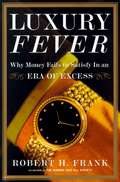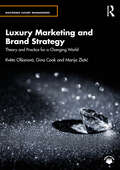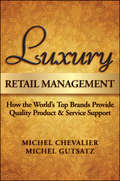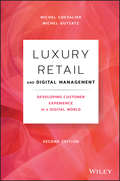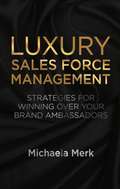- Table View
- List View
Luotang Power: Variances Explained
by Robert L. Simons Craig J ChapmanThe general manager of Luotang Power, a coal-fired power plant located in central China, reviews annual results before a meeting with the board of directors. He thought the company performed well during the year and both plant availability and fuel economy had improved over the previous year. However, the positive performance does not show in the financial results and he must investigate before presenting to the board. He considers performing a variance analysis to better understand plant performance compared to the previous year. He also examines the contractual arrangement the plant has with the provincial power company for a minimum purchase of electricity to supplement regional demand. The company had been successful at selling excess electricity to the power plant but over the past 12 months, demand has decreased. Students must complete a quantitative analysis of the plant's performance and prepare recommendations to improve reporting and evaluation of the plant's performance. This case can be used in an introductory managerial accounting course to explore variance analysis and incentives in contracts.
Lure of Global Branding
by David A. Aaker Erich JoachimsthalerAs more and more companies begin to see the world as their market, brand builders look with envy upon those businesses that appear to have created global brands--brands whose positioning, advertising strategy, personality, look, and feel are in most respects the same from one country to another. Attracted by such high-profile examples of success, these companies want to globalize their own brands. But that's a risky path to follow, according to David Aaker and Erich Joachimsthaler. Why? Because creating strong global brands takes global brand leadership. It can't be done simply by edict from on high. Specifically, companies must use organizational structures, processes, and cultures to allocate brand-building resources globally, to create global synergies, and to develop a global brand strategy that coordinates and leverages country brand strategies. Aaker and Joachimsthaler offer four prescriptions for companies seeking to achieve global brand leadership. First, companies must stimulate the sharing of insights and best practices across countries--a system in which "it won't work here" attitudes can be overcome. Second, companies should support a common global brand-planning process, one that is consistent across markets and products. Third, they should assign global managerial responsibility for brands in order to create cross-country synergies and to fight local bias. And fourth, they need to execute brilliant brand-building strategies. Before stampeding blindly toward global branding, companies need to think through the systems they have in place. Otherwise, any success they achieve is likely to be random--and that's a fail-safe recipe for mediocrity.
Lured by the American Dream: Filipino Servants in the U.S. Navy and Coast Guard, 1952-1970 (Asian American Experience)
by P. James PaligutanStarting in 1952, the United States Navy and Coast Guard actively recruited Filipino men to serve as stewards--domestic servants for officers. Oral histories and detailed archival research inform P. James Paligutan's story of the critical role played by Filipino sailors in putting an end to race-based military policies. Constrained by systemic exploitation, Filipino stewards responded with direct complaints to flag officers and chaplains, rating transfer requests that flooded the bureaucracy, and refusals to work. Their actions had a decisive impact on seagoing military’s elimination of the antiquated steward position. Paligutan looks at these Filipino sailors as agents of change while examining the military system through the lens of white supremacy, racist perceptions of Asian males, and the motives of Filipinos who joined the armed forces of the power that had colonized their nation. Insightful and dramatic, Lured by the American Dream is the untold story of how Filipino servicepersons overcame tradition and hierarchy in their quest for dignity.
Luvo (B)
by Natalie Kindred Jose B. AlvarezThis case, a follow-on to "Luvo" (517-049), provides a brief look at changes that have occured at Luvo, now called Performance Kitchen, since the timing of the first case (mid 2016). Set in January 2020, Luvo (B) touches on developments such as the company's purchase of a small food retail chain and its "food-is-medicine" strategic positioning, which includes selling to health insurers and other firms in the health care industry.
Luxembourg: Selected Issues
by International Monetary FundA report from the International Monetary Fund.
Luxurious Citizens: The Politics of Consumption in Nineteenth-Century America (America in the Nineteenth Century)
by Joanna CohenAfter the Revolution, Americans abandoned the political economy of self-denial and sacrifice that had secured their independence. In its place, they created one that empowered the modern citizen-consumer. This profound transformation was the uncoordinated and self-serving work of merchants, manufacturers, advertisers, auctioneers, politicians, and consumers themselves, who collectively created the nation's modern consumer economy: one that encouraged individuals to indulge their desires for the sake of the public good and cast the freedom to consume as a triumph of democracy. In Luxurious Citizens, Joanna Cohen traces the remarkable ways in which Americans tied consumer desire to the national interest between the end of the Revolution and the Civil War.Illuminating the links between political culture, private wants, and imagined economies, Cohen offers a new understanding of the relationship between citizens and the nation-state in nineteenth-century America. By charting the contest over economic rights and obligations in the United States, Luxurious Citizens argues that while many less powerful Americans helped to create the citizen-consumer it was during the Civil War that the Union government made use of this figure, by placing the responsibility for the nation's economic strength and stability on the shoulders of the people. Union victory thus enshrined a new civic duty in American life, one founded on the freedom to buy as you pleased. Reinterpreting the history of the tariff, slavery, and the coming of the Civil War through an examination of everyday acts of consumption and commerce, Cohen reveals the important ways in which nineteenth-century Americans transformed their individual desires for goods into an index of civic worth and fixed unbridled consumption at the heart of modern America's political economy.
Luxury Brand Management
by Michel Chevalier Gérald MazzalovoThe definitive guide to managing a luxury brand, newly revised and updated What defines a luxury brand? Traditional wisdom suggests that it's one that's selective and exclusive-to such a degree that only one brand can exist within each retail category (automobiles, fragrances, cosmetics, etc. ). But this definition is inherently restrictive, failing to take into account the way in which luxury brands today are increasingly identified as such by their placement in stores and how consumers perceive them. This revised and updated edition of Luxury Brand Management, the first comprehensive book on luxury brand management, looks at the world of branding today. Written by two renowned insiders, the book builds on this new, broader definition of luxury and examines more than 450 internationally known brands from a wide range of industries. Packed with new information covering the financial crisis's impact on luxury brands, and looking towards a new period of growth, the book reconciles management, marketing, and creation with real-life examples and management tools that the authors have successfully used in their professional careers. Includes dedicated chapters focusing on each of the main functions of a luxury brand, including brand creation, the complexity of managing brand identity, the convergence of arts and brands, and much more Addresses the practical functions that can make or break bottom lines and affect brand perception, such as distribution, retailing, logistics, and licensing Focuses on brand life-cycle, brand identity, and licensing issues A compelling and comprehensive examination of the different dimensions of luxury management in various sectors, this new edition of the classic text on brand management is essential reading for anyone working with or interested in making the most of a luxury brand in the post-recession world.
Luxury Brand Management in Digital and Sustainable Times
by Michel Chevalier Gerald MazzalovoLearn about the luxury brand industry from the inside out with this masterful and insightful resource The newly revised Fourth Edition of Luxury Brand Management in Digital and Sustainable Times delivers a timely re-examination of what constitutes the contemporary luxury brand landscape and the current trends that shape the sector. Distinguished experts and authors Michel Chevalier and Gerald Mazzalovo provide readers with a comprehensive treatment of the macro- and micro-economic aspects of management, communication, distribution, logistics, and creation in the luxury industry. Readers will learn about the growing importance of authenticity and sustainability in the management of fashion, perfume, cosmetics, spirits, hotels and hospitality, jewelry, and other luxury brands, as well as the strategic issues facing the companies featured in the book. The new edition offers: A new chapter on the “Luxury of Tomorrow,” with a particular focus on authenticity and durable development A completely revised chapter on “Communication in Digital Times,” which takes into account the digital dimension of brand identity and its implications on customer engagement activities and where the concept of Customer Journey is introduced as a key marketing tool A rewritten chapter on “Luxury Clients” that considers the geographical changes in luxury consumption Considerations on the emerging notion of “New Luxury” Major updates to the data and industry figures contained within the book and a new section dedicated to the hospitality industry New semiotic analytical tools developed from the authors’ contemporary brand management experiences Perfect for MA and MBA students, Luxury Brand Management also belongs on the bookshelves of marketing, branding, and advertising professionals who hope to increase their understanding of the major trends and drivers of success in this sector.
Luxury Brand and Art Collaborations: Postmodern Consumer Culture (Routledge Studies in Luxury Management)
by Federica CarlottoOver the past decades, collaborative initiatives between luxury brands and the art world have been increasing in number and relevance. At first treated as a mere trend or as a marketing stunt, in time luxury-art collaborations have come to be acknowledged as one of the most effective ways luxury brands and artists can position themselves in today’s market, engaging with their clients and audiences. This book sheds light on the socio-cultural valence of luxury-art collaborations. The book explores luxury-art collaborations in the context of postmodern consumption, i.e. as a phenomenon deeply rooted in and emerging from the ways postmodern individuals value and consume objects, contents and ideas. More specifically, the book covers: how collaborations reflect the postmodern condition and liquid consumption practices (hybrid, temporary, hyperreal); the impact of luxury-art collaborations on the evolution of luxury stores and museums, and the emergence of hybrid spaces (art fairs, nomadic exhibitions, pop-up stores) – the temporal features of luxury-art collaborations (shortlived duration and fast-paced tempo) – how luxury-art collaborations reshuffle traditional status dynamics while drawing new boundaries of social distinction based on experience and access – why luxury brands and creatives are redefining their conventional identities, morphing into cultural entities and bricoleurs. The book appeals to a wide range of readers, from academics and students in art business, luxury studies, consumption behaviour, to professionals in the luxury industry and the art world. The book is also relevant to an international readership of non-specialists interested in current social and cultural matters.
Luxury Brands in China and India
by Glyn Atwal Douglas BrysonThis book provides an analysis of the luxury industry in two of the world's biggest and evolving markets, and identifies and discusses the key issues and dynamics in transforming their luxury landscapes. By discussing the elements that are most likely to dominate boardroom agendas, the pragmatic implications for both strategic and marketing planning are made clear. Special emphasis is placed upon well-contemplated responses to luxury brand marketing challenges that executives are likely to face as they push their brands to adapt and thrive in these shifting markets.
Luxury Brands in Emerging Markets
by Glyn Atwal Douglas BrysonThe rewards of success in emerging markets are potentially huge, and as luxury companies continue to expand their global reach, they will need to continually assess if their current strategy is delivering competitive advantage. Luxury Brands in Emerging Markets is an invaluable repository of knowledge that brings clarity to key issues and trends for practitioners, academics and students of luxury brands. It sets out to decode the luxury markets in the primary emerging markets (BRICs) and provide a rich resume of the key factors that influence the effectiveness of luxury brand strategies. Emerging markets are incessantly evolving and the continuous need for new market intelligence will be critical in addressing complex issues and delivering business success. It is these new insights at the very frontiers of new knowledge and practice that will provoke dialogue and debate in the boardroom, as well as in classrooms that are preparing future luxury company executives.
Luxury China
by Michel Chevalier Pierre LuA guide to reaching and profiting from China's expanding luxury consumer class China's growing consumer base and expanding economy means more disposable income for more Chinese citizens. The Chinese market for luxury goods is expected to expand from $2 billion this year to nearly $12 billion by 2015. Today's biggest global luxury goods retailers expect China to make up a large and ever growing portion of their customers, and those businesses are responding with new stores and investments in China. Luxury China gives readers-particularly professionals in advertising, marketing, and the luxury brands industry-a deep look into the future of the Chinese luxury goods market and shows them how to tap into China's tremendous market potential.
Luxury Fashion Brand Management: Unifying Fashion with Sustainability (Mastering Fashion Management)
by Olga MitterfellnerThis textbook examines fashion luxury brand management, providing students with a comprehensive understanding of its origins, unique components, current practices, global trade and, most importantly, the application of sustainable models to the industry. It also highlights what makes brands fail and how they can become more resilient. The key content covers the heritage of luxury brands, the importance of craftsmanship and creative direction, the role of luxury conglomerates, cultural awareness and internationalisation, risks of failure and opportunities for revitalisation as well as the application of sustainable measures for a resilient and ethical brand future. Each chapter includes a combination of industry insights, case studies or expert interviews. Coupled with theoretical frameworks and business models, these examples and case studies show how sustainable models can be applied to existing luxury brands and how practices can be embedded into the brand concept. Students are encouraged to think about opportunities and solutions, unique to luxury brand management, and will gain knowledge and skills for a successful future career. A truly global and holistic textbook, Luxury Fashion Brand Management and Sustainability should be core and recommended reading for advanced undergraduate and postgraduate students studying luxury fashion management, luxury brand management, sustainable fashion and responsible business and fashion marketing and communications. Supplementary online resources include chapter-by-chapter PowerPoint slides and a test bank.
Luxury Fashion Brand Management: Unifying Fashion with Sustainability (Mastering Fashion Management)
by Olga MitterfellnerThis textbook examines fashion luxury brand management, providing students with a comprehensive understanding of its origins, unique components, current practices, global trade and, most importantly, the application of sustainable models to the industry. It also highlights what makes brands fail and how they can become more resilient. The key content covers the heritage of luxury brands, the importance of craftsmanship and creative direction, the role of luxury conglomerates, cultural awareness and internationalisation, risks of failure and opportunities for revitalisation as well as the application of sustainable measures for a resilient and ethical brand future. Each chapter includes a combination of industry insights, case studies or expert interviews. Coupled with theoretical frameworks and business models, these examples and case studies show how sustainable models can be applied to existing luxury brands and how practices can be embedded into the brand concept. Students are encouraged to think about opportunities and solutions, unique to luxury brand management, and will gain knowledge and skills for a successful future career. A truly global and holistic textbook, Luxury Fashion Brand Management and Sustainability should be core and recommended reading for advanced undergraduate and postgraduate students studying luxury fashion management, luxury brand management, sustainable fashion and responsible business and fashion marketing and communications. Supplementary online resources include chapter-by-chapter PowerPoint slides and a test bank.
Luxury Fashion Marketing and Branding: A Strategic Approach (Mastering Fashion Management)
by Alice DallabonaLuxury Fashion Marketing and Branding offers a comprehensive analysis of the key theories and concepts needed to understand the promotion of luxury fashion products. It covers subjects including luxury fashion retailing, digital marketing and communication, data analytics, emerging technologies, consumer behaviour and PR. The textbook also offers a focused discussion of the challenges faced by luxury fashion brands to meet growing customer demand for ethical and sustainable practice, including concerns related to diversity, inclusivity, and cultural sensitivity.This textbook is grounded in business practices, featuring real-world examples and international case studies from both established and modern brands. Chapter objectives and summaries aid comprehension, whilst end-of-chapter questions and activities enable further research and discussion.Luxury Fashion Marketing and Branding is ideal for advanced undergraduate and postgraduate students of fashion marketing and communications, luxury fashion business and luxury brand management. Its applied approach will also make it suitable for those studying for an Executive MBA in Fashion and Luxury Management. Online resources include an instructor’s manual, lecture slides and a test bank.
Luxury Fashion Retail Management
by Tsan-Ming Choi Bin ShenUsing various research methodologies, such as reviews, case studies, analytical modeling and empirical studies, this book investigates luxury fashion retail management and provides relevant insights, which are beneficial to both industrialists and academics. Readers gain an understanding of luxury fashion retailing, including proper operations and strategic management, which now are the most crucial items on the luxury fashion industry's senior management agenda.
Luxury Fever
by Robert H. FrankA new luxury fever has America in its grip. Independent of stock prices, recessions, and inflation rates, the past two decades have witnessed a spectacular and uninterrupted rise in luxury consumption. Ordinary, functional goods are no longer acceptable. Our cars have gotten larger, heavier, and far more expensive. Mansions larger than 30,000 square feet no longer seem extravagant. Wristwatches for the super-rich cost tens of thousands of dollars. We are living in an era of excess. Consider: The average house built in the United States today is nearly twice as large as its counterpart from the 1950s. Even as houses have gotten more expensive and farther from the workplace, there has been a sharp increase in second-home ownership. The average price of an automobile sold in the United States now exceeds $22,000, up more than 75 percent from a decade ago. Total U.S. spending on luxury goods increased 21 percent between 1995 and 1996 (typical of recent years), while overall merchandise sales increased only 5 percent. Robert Frank caused a national debate in 1995 when he and co-author Philip Cook described the poisonous spread of "winner-take-all" markets. Now he takes a thought-provoking look at the flip side of spreading inequality: as the super-rich set the pace, everyone else spends furiously in a competitive echo of wastefulness. The costs are enormous: We spend more time at work, leaving less time for family and friends, less time for exercise. Most of us have been forced to save less and spend and borrow much more. The annual rate at which American families file for personal bankruptcy has grown to one in seventy. Budgetary pressures have reduced our willingness to fund even essential public services: Our food and water are increasingly contaminated. Potholes proliferate, and traffic delays double every ten years. Frank offers the first comprehensive and accessible summary of scientific evidence that our spending choices are not making us as happy and healthy as they could. Furthermore, he argues that human frailty is not at fault. The good news is that we can do something about it. We can make it harder for the super-rich to overspend, and capture our own competitive energy for the public good. Luxury Fever boldly offers a way to curb the excess and restore the true value of money.
Luxury Marketing and Brand Strategy: Theory and Practice for a Changing World (Mastering Luxury Management)
by Květa Olšanová Gina Cook Marija ZlatićThis text provides a comprehensive and strategic overview of luxury marketing and brand management, guiding brands to balance tradition with innovation as they navigate modern challenges and seize opportunities in a rapidly evolving global market. The book explores the core aspects of luxury branding, including the defining traits of luxury brands, the dominance of major luxury groups and the resilience of independent brands with storied histories. It explores the delicate balance required to maintain a brand’s luxury status amidst evolving consumer expectations, technological advancements and sustainability concerns. Students will gain insight into innovative marketing strategies, from the use of NFTs and blockchain to the integration of AI and the metaverse in enhancing customer experiences. Offering a clear and engaging pathway through the complexities of luxury brand management, the authors draw on their extensive academic and professional experience, presenting a rich blend of theoretical insights and real-world global and cross-industry case studies from prestigious brands like Cartier, Van Cleef & Arpels, Chanel, Ferrari, Orient-Express and many others. This textbook is designed to be the cornerstone for advanced undergraduate and postgraduate courses in luxury marketing and luxury brand management. With a focus on the latest trends and future directions in luxury marketing, Luxury Marketing and Brand Strategy is not only an academic resource but also a practical guide for navigating and succeeding in the dynamic luxury market. Online resources include PowerPoint lecture slides for each chapter, sample answers for discussion questions, and a test bank. Please visit www.routledge.com/9781032973951.
Luxury Marketing, Sustainability and Technology: The Future of Luxury Management (Routledge Studies in Luxury Management)
by Park Thaichon Sara QuachLuxury Marketing, Sustainability and Technology explores how new technologies, sustainability and relationship marketing impact and change the future of luxury brand management. Whilst the luxury industry is experiencing exponential growth, further research is vital to improve knowledge and understand how luxury management operates in the new age of marketing. Through a range of empirical and theoretical contributions, this book offers clear insights on relationship marketing and luxury management. It examines the growth of luxury, marketing strategies for luxury brands, advertising and communication of luxury brands, AI and disruptive technology in luxury marketing, and sustainability and pro-environmental luxury. All the chapters close with practical summaries and recommendations for businesses practice. This book is a useful reference for scholars and postgraduate researchers across luxury management and marketing, including those interested in international marketing, social media marketing, fashion management, as well as innovation management and sustainability.
Luxury Retail Management: How the World's Top Brands Provide Quality Product and Service Support
by Michel Gutsatz Michel ChevalierNoted experts offer invaluable insights into the glamorous world of luxury retail Luxury Retail Management is your gold-plated ticket to the glamorous world of luxury retail. Defining all the tools that are necessary to manage luxury stores, from the analysis of location and design concept, to the selection, training, and motivation of the staff, the book covers everything you need to know to enter, expand, understand, and succeed in the world of luxury retail. Reaching the luxury customer is no longer the domain of the exclusive salon—the global luxury market boom and the phenomenal growth of luxury stores now views the retail sector as key to driving brand profitability. In dealing with this rapid change, luxury brands have experienced a steep learning curve and accumulated bags of retail expertise. And while some of the luxury retail rules and models in this book are exclusive to the luxury market, many have lessons for the whole retail sector. Examines the essential aspects of luxury customer relationship management, personal sales, and the customer experience Delves into the sophisticated business models that luxury brands have developed based on a mix of directly-operated-stores and wholesale Covers the management essentials—distribution, location, design, merchandising, pricing, brand promotion, and the management agenda for success Written by respected experts Michel Chevalier and Michel Gutsatz, who lend their solid academic credentials and professional expertise to the subject, Luxury Retail Management asks and answers the questions that retail professionals need to understand in order to thrive in the luxury market.
Luxury Retail and Digital Management: Developing Customer Experience in a Digital World
by Michel Gutsatz Michel ChevalierDevelop a winning customer experience in the digital world Luxury consumers are changing – they come from all over the world, they are young and they are digital natives. How can luxury brands that have built themselves as pure physical players adapt their business model and practices to address their expectations without abandoning their luxury DNA? Luxury Retail and Digital Management, 2nd Edition sets focus on the major retailing challenges and customer evolutions luxury brands are facing today: the digitalisation and the emergence of the millennials and Chinese luxury consumers. These major changes have been affecting the distribution and communication channels of luxury brands; they now have to think simultaneously physical stores and e-commerce, global marketing and digital marketing. • Defines all the tools that are necessary to manage luxury stores including analysis of location and design concept • Explores the selection, training and motivation of the staff • Covers everything executives, managers and retail staff need to know in order to enter, expand, understand and succeed in the world of luxury retail Written by luxury retail experts Michel Chevalier and Michel Gutsatz, who lend their solid academic credentials and professional expertise to the subject, Luxury Retail and Digital Management, 2nd Edition provides deep insight into the main challenges that luxury brands are facing in this digital age.
Luxury Sales Force Management
by Michaela MerkThe sales team can often make or break the success of new brands or products. This comprehensive guide provides strategies, models and checklists to help managers and directors strengthen the relationships of their firm's sales force with their own or other brands, maximizing turnover and profit in the long run.
Luxury Selling
by Francis SrunSrun shows how the psychology of luxury brands truly plays into high value customer motivations and unlocks the potential to understand their decision processes which are unlike that of any other customer. Selling to very wealthy, demanding customers - whether you're selling luxury products or high value bespoke professional services - is a very different process to selling anything else to anyone else. Francis Srun has twenty years experience in the luxury industry, based in France, Switzerland, China and Hong Kong, most recently with Maison Boucheron. The first step is learning how to physically embody "Luxury". You need to look, speak, and move "Luxury". The true luxury attitude is not submissive nor is it hauteur - it is gentle, generous and simply, truly human. Success comes from not just being professional but from building a genuinely luxury relationship with clients. To do that you need to truly understand your client. High value customers today are younger, international in outlook and residence, and increasingly from Asia. Their buying motivation is always about self-affirmation and pleasure and never about money. The luxury customer's decision process is unlike that of other customers. While emotion is important when selling anything to anyone - with luxury selling it is paramount. Srun shows how the psychology of Brand, Product, Place, Price and Time all play a role in customer's motivations. Finally this book guides you step by step with concrete examples and useful techniques through the seven steps of luxury selling: be prepared to sell, welcome appropriately, listen genuinely, propose and present with style, meet objections with persuasion rather than refutation, conclude sharply and finally gain loyalty for a long term relationship.
Luxury Strategy In Action
by Jonas Hoffmann Ivan Coste-Mani�reWritten by experts in Luxury and Fashion Management at SKEMA Business School this exciting new book offers a new perspective that challenges the established rules of the luxury and fashion industry. The authors and contributors examine the evolution of luxury strategy and how the luxury industry is being redefined in the twenty-first century.












